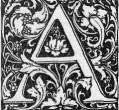 HOME
HOMEEncyclopedia Home Page
A
AA - ACA
ABBREVIATIONS
ACC - ADONI
ADONIS - AHIAH
AHIM - ALLE
ALLI - AMER
AMERICAN (MILITARY) UNION LODGE
AMET - ANDRE
ANDREA - ANTOI
ANTON - ARCHIT
ARCHIV - ASHLAR
ASHM - AZ


by ALBERT G. MACKEY M.D.
Revised by ROBERT I. CLEGG
In the Accadian, Greek, Etruscan, Pelasgian, Gallic, Samaritan, and Egyptian or Coptic, of nearly the same formation as the English letter. It originally meant with or together, but at present signifies one. In most languages it is the initial letter of the alphabet not so, however, in the Ethiopian, where it is the thirteenth. This familiar first letter of the alphabet comes down to our own modern times from the most remote period recorded of the world's history. The common form of the letter corresponds closely to that in use by the Phoenicians at least ten centuries before the Christian Era, as in fact it does to almost all its descendants. Men of Tyre were Phoenicians, and we may trace the sound of the name they gave this letter by noting the pronunciation of the first letters in the alphabets of the Hebrews and the Greeks who took them from the same source. We derive the word alphabet from the first two Greek letters, and these are akin in their names to the Hebrew Aleph, or Awlef, and Bayth. Sounds of these letters, as in English words, must not be confused with the pronunciation of the names for them. The name of the Hebrew Aleph, signifies ox from the resemblance of the letter to the head and horns of that animal.
The sacred Aleph has the numerical value of one and is made up of two Yodes, one on each side of an inclined bar or Vawv. This combination of characters is said to typify the Trinity in Unity. The Divine name in Hebrew connected with this letter is, A H I H.
[- Next: AA - ACA -]